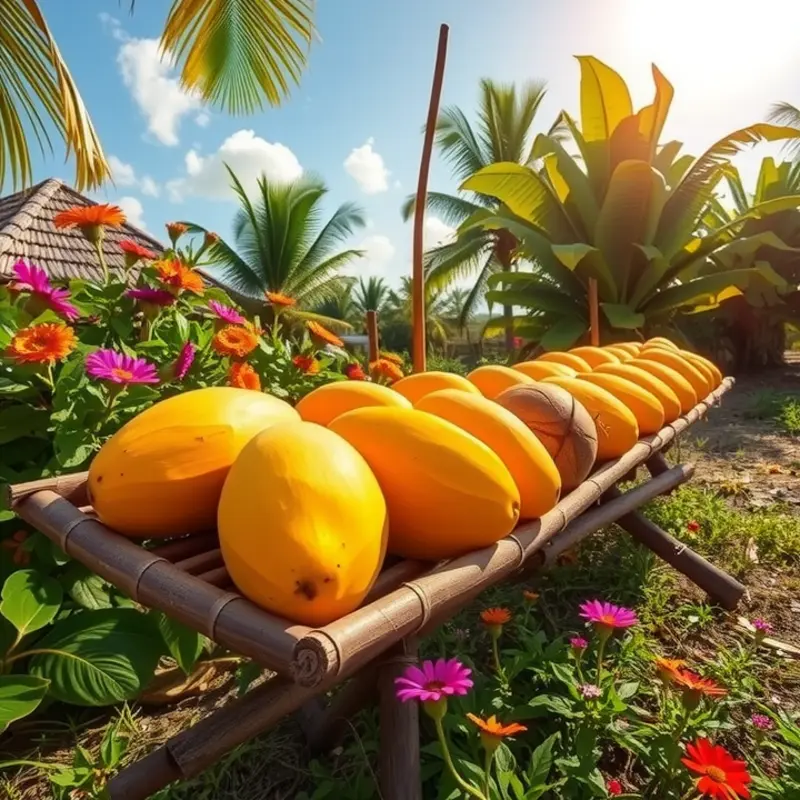Island communities have developed innovative methods of food preservation rooted in their cultural narratives, geographic limitations, and natural resources. Through these practices, they extend the shelf life of seasonal ingredients while embedding flavors and traditions into their culinary heritage. From fermenting fish in Japan to sun-drying tropical fruits in the Caribbean, these techniques reflect a deep respect for the land and sea, while fostering resilience and sustainability. Let’s delve into the world of island food preservation, celebrating the unique cultural expressions and flavors they offer.
The Art of Fermentation: Tidal Techniques in Japan

Japanese cuisine is renowned for its remarkable use of fermentation, a technique deeply rooted in coastal areas. Among these practices, narezushi stands out as an age-old art. This delicacy, believed to be the predecessor of modern sushi, utilizes fermented fish and rice to achieve its distinct flavor profile. The process involves curing fish, typically mackerel, in salt for several months, then layering it with rice in wooden barrels to ferment, resulting in an amalgam of intense umami flavors.
The Japanese concept of umami, often recognized as the fifth taste, is central to these culinary traditions. Umami’s depth enhances not only narezushi but also a suite of other fermented delights such as miso and soy sauce. These condiments rely heavily on the rich tapestry of sea life, including seaweed and small fish, which imbue them with that signature depth so sought after in cuisines worldwide.
Miso, a paste made from fermented soybeans, rice, or barley, exemplifies how communities have long harnessed the ocean’s bounty to sustain and enrich their diets. Families in coastal villages might ferment their own batches, each reflecting a unique recipe passed down through generations. The fermentation process can take up to a year, during which the environment’s microbes work their magic, unlocking complex flavors and extending the shelf life of soy and grains.
Similarly, soy sauce is crafted through the fermentation of soybeans and wheat, inoculated with a special mold known as koji. The careful balancing of ingredients and fermentation time results in a dark, savory liquid indispensable in Japanese cooking. This condiment not only brings flavor but historically played a role in preserving foods in humid summer months when spoilage was a significant concern.
Culturally, these fermentation processes hold more than just culinary significance. Rituals often accompany production, reflecting respect and gratitude for the sea’s offerings. Many small communities still gather during seasonal cycles to prepare these traditional foods, intertwining their existence with nature’s rhythm.
This intricate relationship with fermentation extends beyond mere sustenance. It has woven itself into folklore, with tales of sea gods blessing the fish that transforms into delicious, sustainable sustenance, echoing the sentiments found in various global traditions.
For a deeper understanding of umami and fermentation’s role in promoting gut health, explore foods for balancing gut flora. Here, the interaction between tradition and modern nutritional science offers further insight into why such age-old practices continue to be revered today.
The umami-rich heritage of Japanese fermentation techniques exemplifies how cultural practices born out of necessity have transformed into cherished traditions. These methods not only maintain their relevance within Japan but continue to influence and captivate palates worldwide.
Solar Flavors: Drying Techniques in the Caribbean

The dazzling Caribbean sun serves not only to tan its visitors but also to imbue dried fruits with intense flavors. Sun-drying fruits in the Caribbean is an art passed through generations, preserving the vibrant essence of mangoes, papayas, and coconuts.
The method begins with selecting the ripest fruits, harvested with consideration from luscious groves that dot the islands. Sliced and spread on handwoven mats or bamboo racks, they bask under the sun. This simple yet effective process enhances their natural sweetness, concentrating sugars and infusing vitality into each piece.
Papaya, for example, transforms profoundly when dried. The fleshy orange slices are sun-kissed until they become chewy treats. These are enjoyed as snacks and sometimes rehydrated to be incorporated into rich Caribbean stews or curries, infusing them with an enlivened zest.
Coconut, an island staple, is grated and dried to maintain its sweet, milky flavor. Desiccated coconut is a crucial ingredient, used in baking, topping tropical desserts, and concocting the beloved coconut rice.
Mangoes hold a celebrated status in the Caribbean, with entire festivals dedicated to their magnificence. When dried, the mango retains its tropical delight but with a tartness that dances on the palate. These dried slices are popular as snacks but also find their place in chutneys and sauces, marrying local spices to create a tapestry of sensations.
Culturally, these drying practices tie communities to their ancestors. Communal drying sessions are lively events, filled with music and laughter, reinforcing community bonds. These gatherings are reminiscent of times when island tribes would come together, ensuring sustenance through collaborative efforts.
Beyond cultural connection, drying techniques also showcase the Caribbean commitment to sustainable practices. Dried fruits reduce food waste, giving longevity to seasonal bounties and supporting local economies. The method aligns well with eco-friendly eating practices that focus on minimizing the ecological impact of our diets. Explore more about minimizing ecological diet impacts.
Unveiling the flavors of the Caribbean through sun-drying offers an insightful glimpse into a natural preservation technique that honors the land’s history. It illustrates how traditional methods still resonate deeply within these vibrant cultures, maintaining a link to their heritage while adapting to modern culinary opportunities. Sun-drying, thus, stands as a testament to the islanders’ resourcefulness and their harmonious relationship with nature.
Final words
Island food preservation techniques not only extend the life of ingredients but also serve as vessels of cultural heritage, narrating stories of resilience, creativity, and community bonding. From Japanese narezushi to Caribbean sun-dried delights, these traditions allow us to appreciate the deep ties between people and their environment. Engaging with these methods encourages a respectful exploration of their origins, celebrates their uniqueness, and fosters culinary experimentation in our kitchens. As we embrace these time-honored practices, we contribute to the ongoing narrative of sustainability and flavor that transcends cultures.








